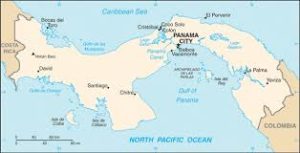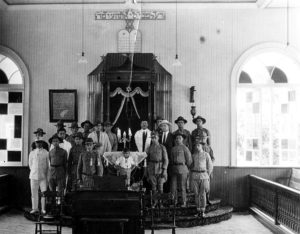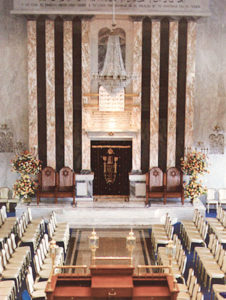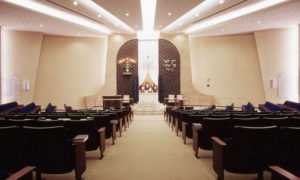 The first Jews to reside in Panama were Conversos, who had fled the Iberian Peninsula during the Spanish Inquisition. The country was under colonial rule for the subsequent three centuries, until it broke from Spain in 1821. After this, there was an influx of Sephardi Jews from Jamaica and Ashkenzi Jews from Europe. However, they did not develop a community.
The first Jews to reside in Panama were Conversos, who had fled the Iberian Peninsula during the Spanish Inquisition. The country was under colonial rule for the subsequent three centuries, until it broke from Spain in 1821. After this, there was an influx of Sephardi Jews from Jamaica and Ashkenzi Jews from Europe. However, they did not develop a community.
 In the 1850s, as the Panamanian railroad crossing from Atlantic to the Pacific was completed, more Jews came, and this time a community took hold. Panama’s first synagogue, Kol Shearith Israel, was founded in 1876 in Panama City, Ashkenazi Jews from Curaçao. (It is currently owned by a church group, Igelsia Evangélica). The new Kol Shearith Israel is an ivory-toned building composed of cascading semicircles. It is adorned with two-toned clay Ten Commandment tablets, and the façade is topped by a large Magen David. In 1890, the Kahal Hakadosh Yangacob Synagogue opened in Colon.
In the 1850s, as the Panamanian railroad crossing from Atlantic to the Pacific was completed, more Jews came, and this time a community took hold. Panama’s first synagogue, Kol Shearith Israel, was founded in 1876 in Panama City, Ashkenazi Jews from Curaçao. (It is currently owned by a church group, Igelsia Evangélica). The new Kol Shearith Israel is an ivory-toned building composed of cascading semicircles. It is adorned with two-toned clay Ten Commandment tablets, and the façade is topped by a large Magen David. In 1890, the Kahal Hakadosh Yangacob Synagogue opened in Colon.
During World War I, Jews came to the country fleeing the collapse of the Ottoman Empire. Likewise during the inter-war period, many Jews sought refuge in Panama from the rise of fascism throughout Europe. Similarly, many settled in the country post-World War II. Jewish immigration led to the opening of two more synagogues in Panama City.
 In 1933, Jews of Syrian origin established an Orthodox synagogue called Shevet Achim, which is now the largest congregation in Panama. Topped by a monumental chanukkiyah, it has a grand arched entrance, Ten Commandment tablets and several wings of varying heights, vertically striped with stained-glass windows. The Shevet Achim community, is so large that in addition to its main synagogue, several satellite synagogues such as, Ahavat Zion, have been built. The bulk of Panamanian Jews are of Syrian descent, and their community is closely knit and committed to preserving Jewish continuity.
In 1933, Jews of Syrian origin established an Orthodox synagogue called Shevet Achim, which is now the largest congregation in Panama. Topped by a monumental chanukkiyah, it has a grand arched entrance, Ten Commandment tablets and several wings of varying heights, vertically striped with stained-glass windows. The Shevet Achim community, is so large that in addition to its main synagogue, several satellite synagogues such as, Ahavat Zion, have been built. The bulk of Panamanian Jews are of Syrian descent, and their community is closely knit and committed to preserving Jewish continuity.
Eastern European Jews fleeing the Nazis opened Beth El later that decade. Beth El is the only Ashkenzi synagogue and features a simple hall tastefully decorated with white walls and wrought-iron filigree.
Prior to the State of Israel, in 1948, there was a mass Jewish exodus from Syria to Panama, to avoid persecution. Another wave of Syrian Jews came to Panama in the 1970s, and even more emigrated from Syria in the 1990s following the toppling of Panama’s dictatorial regime. In the 1990-2000s there was another wave of immigrants, who came mainly from Colombia, Venezuela and Argentina, suffering economic crises. Also, 1,000 Israelis arrived.
The centre of Jewish life in Panama is Panama City, although small groups of Jews settled in other cities, like Colon, San José de David, Chitre, La Chorrera, Santiago de Veraguas and Bocas del Toro. Those communities are largely disappearing. Families moved to the capital in search of education for their children and for economic reasons.
 Panama City’s 15,000 Jews can choose from 4 synagogues, 4 Jewish day schools, an a number of kosher shops including Super Kosher, a 1,500 square metre supermarket which sells close to 10,000 different kosher products made in Israel, the U.S., Europe and in Panama. This store is reportedly the largest kosher emporium outside of Israel. There are also around 25 kosher restaurants.
Panama City’s 15,000 Jews can choose from 4 synagogues, 4 Jewish day schools, an a number of kosher shops including Super Kosher, a 1,500 square metre supermarket which sells close to 10,000 different kosher products made in Israel, the U.S., Europe and in Panama. This store is reportedly the largest kosher emporium outside of Israel. There are also around 25 kosher restaurants.
 Almost all children go to Jewish day schools, where they get a traditional outlook on life that automatically brings less intermarriage. The Jewish day school – Instituto Alberto Einstein, which was founded in 1954, consists of pre-primary, primary and secondary grades, and provides secular and Jewish education of high academic standards. There are also the Academia Hebrea de Panama and Colgeio Isaac Rabin.
Almost all children go to Jewish day schools, where they get a traditional outlook on life that automatically brings less intermarriage. The Jewish day school – Instituto Alberto Einstein, which was founded in 1954, consists of pre-primary, primary and secondary grades, and provides secular and Jewish education of high academic standards. There are also the Academia Hebrea de Panama and Colgeio Isaac Rabin.
It is estimated that 80 to 95 percent of Panama’s Jews are affiliated with the community and 80 to 85 percent keep kosher.